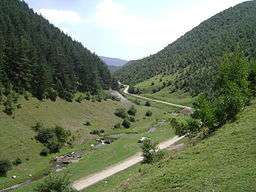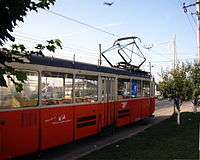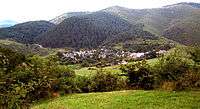Rășinari
Coordinates: 45°42′N 24°04′E / 45.700°N 24.067°E
| Răşinari | |
|---|---|
| Commune | |
|
The "New Church" in Răşinari | |
 Location of Răşinari | |
| Country |
|
| Status | Commune |
| Government | |
| • Mayor | Ioan Bucur Băra (Democratic Party) |
| Area | |
| • Total | 127.87 km2 (49.37 sq mi) |
| Population (2011) | |
| • Total | 5,280 |
| Time zone | EET (UTC+2) |
| • Summer (DST) | EEST (UTC+3) |
| Website | http://www.cjsibiu.ro/ro/rasinari.php |
Răşinari (German: Städterdorf; Hungarian: Resinár) is a commune in Sibiu County, Transylvania, Romania. It has a population of 5,280 inhabitants (2011 census) and is composed of two villages, Prislop (Priszloptelep) and Răşinari.
Until 2012, Răşinari was connected to Sibiu by a roughly 8-km tram line through the Dumbrava Forest, but regular service ended in 2011[1] and since 2013 much of the line has since been dismantled.
History
In 1738 it was noted that the settlement was built by Mustaţă and Rosca Coman who built home in the place where the Fountain redhead is today, in the middle of the state. In the second half of the 18th century, the Răşinari Orthodox bishop church was formed - the first one of its kind in Transylvania. Today the pastoral traditions of the village are incorporated in the new modern rhythm of life.
Tram line


From 1947, Răşinari was linked to Sibiu by an electric tram line which crossed Dumbrava Forest, but service became sporadic in the late 2000s and ceased entirely on 28 February 2011.[1] Very limited operation that took place later – mainly only for visiting tourist groups – ended in 2012,[2] followed in 2013 by the start of work to dismantle the line. It is hoped to reopen a portion as a heritage tramway.[2] The trams in use since the mid-1990s were formerly used in Geneva and retained their French-language signs.[3] In 2013, they were sold to Răşinari for a low price and moved to the Răşinari end of the tram line, just before work to remove the tracks and overhead trolley wires began.[2] Officials in Răşinari are attempting to obtain funding to build a small depot (carhouse) and to reopen a portion of the line as a tourist attraction.[2]
Demographics
The 1930 Census registered 5281 inhabitants, of which 5229 were Romanian, 32 Gypsies, 13 Germans, 4 Hungarians. At the 2002 Census, the same percentages were maintained, with 5529 inhabitants registered.
Prislop

Prislop village has around 300 residents (as of 2010), of whom about 15 are ethnic Romanians and the rest Roma. However, at the 2002 census, the latter declared as Romanians, as they speak Romanian and not Romani. This caused the village to miss out on European Union funds for Roma integration. There is one school from kindergarten to 4th grade; pupils who finish can go on through 8th grade in Răşinari.[4]
Sights
- Andrei Saguna Metropolitan monument
- "St. Parascheva" Church
- Octavian Goga memorial house
- The ruins of the medieval fortress of Cetatuia Citadel
- Ethnographic Museum
- Ward Museum (set up in the former residence of the bishops)
Natives
- Daniel Popovici Barcianu
- Traian Bratu
- Eugen Brote
- Emil Cioran
- Octavian Goga
- Ioan Ilcușu
- Ilarie Mitrea
- Stan Vidrighin
References
- 1 2 Tramways & Urban Transit, May 2011, p. 194. UK: LRTA Publishing.
- 1 2 3 4 Blickpunkt Straßenbahn issue "4/2013" (July–August 2013), pp. 142–143 (in German). ISSN 0173-0290.
- ↑ BeyondTheForest.com, Trams in Romania
- ↑ "Culture and Education" at Răşinari Town Hall; accessed September 3, 2011
| Wikimedia Commons has media related to Category:Răşinari, Sibiu. |

